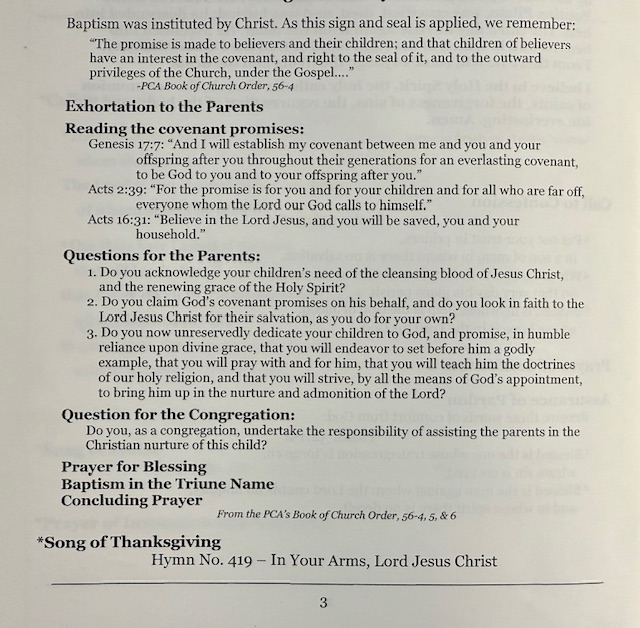This past Sunday at our church, we witnessed something beautiful. A little child was baptized in the name of the Father, the Son, and the Holy Spirit. He didn’t say a word. He didn’t walk an aisle. He didn’t profess his faith in front of a crowd. He simply received. And in that, the beauty of baptism shone all the more clearly.
Because baptism is not, first and foremost, a statement we make about our faith. It is a statement God makes about His.
Baptism Is God’s Work, Not Ours
I had long assumed, as many do, that baptism was something we did to show the world we were serious about following Jesus. That it was a symbol of our commitment. And if that’s the case, then infant baptism doesn’t make much sense—after all, babies can’t testify, decide, or declare. But the more I studied Scripture, the more I saw that this way of thinking puts the spotlight in the wrong place.
In the Bible, baptism is God’s sign and seal of His promises. He is the one acting. We are the ones receiving.
But let me be absolutely clear: the Reformed and papal theologies of baptism bear no resemblance whatsoever to one another.¹ The Roman Catholic view teaches that the waters of baptism themselves cause regeneration ex opere operato—by the mere act itself. The Reformed view, by contrast, affirms that baptism is a sign and seal of the covenant of grace. It does not confer saving grace automatically. The waters do not regenerate. Only the Holy Spirit does that, in His own time and sovereign way.
So when we baptized this child, we were not saying that he was now born again. What we were saying is that he has been marked with the sign of God’s covenant promises, just as the children of Abraham were. He will need to grow up and one day personally trust in Christ. He will need to believe the gospel message he hears, repent of his sins, and lay hold of Jesus by faith. Baptism does not replace that. It points to that.
The Gospel Is for Families and for Individuals
The gospel reaches people in households and in solitude, across generations and one soul at a time. It is for individuals—and it is for families. Both categories appear consistently throughout redemptive history. And both are clearly named in Peter’s Pentecost sermon: “The promise is for you and for your children and for all who are far off, everyone whom the Lord our God calls to Himself” (Acts 2:39).
Two kinds of people should receive the covenant sign of baptism: converts to Christ and the children of believers. This is the clear pattern of Scripture. In the Great Commission, Jesus commands His disciples to make disciples of all nations, baptizing them in the Triune name. This applies not just to the first generation of converts but to their children, just as God always included the offspring of His people in His redemptive plan.
Covenant Continuity and Household Baptisms
God initiated His covenant with Abraham, giving him circumcision as a sign—not as a reward for faith, but as a seal of the righteousness he had by faith (Romans 4:11). That sign was to be applied not only to Abraham but to his household, because God promised, “I will be your God and the God of your offspring after you” (Genesis 17:7).
When the apostles administered baptism, they did so not in isolation from this covenantal heritage but in continuity with it. The book of Acts records several household baptisms—Lydia’s household, the Philippian jailer’s, Crispus’s, and Stephanas’s. The use of household language signals something important: the covenant sign continues to fall upon believers and their children. That continuity is not revoked in the New Testament; it is reaffirmed.
Paul tells the Corinthian church that the children of even one believing parent are “holy” (1 Corinthians 7:14)—not inherently saved, but covenantally set apart. That word, “holy,” echoes the Old Testament categories of inclusion in the worshiping community. To be holy is to belong to God.
Should we now believe that in the New Covenant—where the promises are better (Hebrews 8:6)—God suddenly becomes less generous with His signs?
The Burden of Proof
Some argue that unless the New Testament gives a specific verse showing an infant being baptized, the practice is invalid. But this assumes that the New Testament must restate every Old Testament truth unless explicitly reiterated. In reality, the burden of proof lies the other way. If children were included in God’s covenant community before, one must show that they are now excluded. That case cannot be made.
Throughout Scripture, God treats the children of believers as belonging—set apart, addressed, and instructed. Paul speaks directly to children in Ephesians 6 as members of the church, applying to them the promises of the fifth commandment. That is not incidental language; it is covenantal.
A Word to Believers and the Church
To the parents, I exhorted them to raise their child in the nurture and admonition of the Lord, leaning upon God’s mercy and grace. To the congregation, I reminded them of their own baptisms—whether received in infancy or adulthood. We are all called to “improve upon our baptism,” as the Westminster Larger Catechism puts it—to remember our union with Christ, to renounce the world, the flesh, and the devil, and to walk in newness of life.
And to those who have not yet come to Christ: hear the apostolic invitation—Repent and be baptized, you and your children.
Don’t Withhold What God Has Promised
It’s easy to see baptism as our work. But Scripture is clear—baptism is God’s word, His sign, His seal. It points not to our decision, but to Christ’s blood and the Holy Spirit’s renewal. It marks the recipient as belonging to God, as one called to faith, just as circumcision did for the children of Israel.
So, I say again: Give the covenant sign to your children.
Trust the God who said He will be God to you and to your children after you. Don’t withhold what He freely gives. And don’t underestimate the power of a God who keeps His promises—even the ones He makes to the smallest among us.
¹ Bryan Holstrom, Infant Baptism and the Silence of the New Testament (Greenville, SC; Belfast, Northern Ireland: Ambassador International, 2008), 19.

